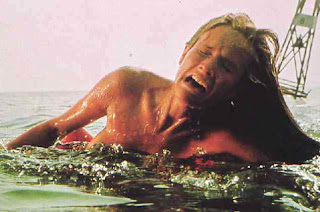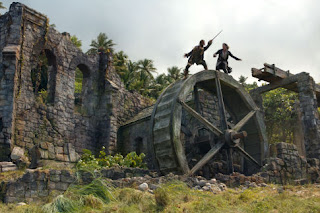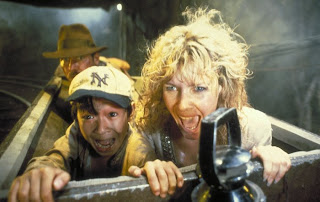Jaws- Opening Scene:
 Diegetic
Diegetic - A lot of the sound where the party is taking place is diegetic sound. The man singing with his guitar, the sound of the crackling fire, the sound of the teenagers laughing and joking are all examples of the diegetic sound used.
When the girl is in the water and Jaws begins to attack her, you hear a lot of splashing and the sound of water lapping at the shore. These are other examples of diegetic sound as they have been placed in the movie to make the scene seem more realistic as it is what the audience would expect to hear in a situation like that.
Non-Diegetic - The famous soundtrack that is used throughout the JAWS movie to signal that the shark is coming is an example of non-diegetic sound. It does not actually take place in the movie as the characters cannot hear it yet it has been put on afterwards to make the audience feel scared and to create suspense as we know that sound to mean danger and a scary shark. In the opening scene the music begins to play when you are in the POV shot of the shark underwater before it attacks the teenage girl showing that it is something that relates to the shark and it acts as a warning signal to the audience.
 Diegetic
Diegetic - Throughout the whole scene the sound of swords is heard a lot as that is what they are using to fight. This is diegetic sound as the sound relates to the action taking place on screen and the swords would really be making that sound in real life when they are being used to fight.
Other types of diegetic sound used are the sand on the beach, the bushes in the forest, the sound of cutting through objects such as flesh and rope, the sound of breaking wood, the metal beam hitting Jack on the head, the falling key, and creaking wood as these are all sounds which appear in the movie world and that the characters would be able to hear along with the audience as they take place because of the things that occur on screen.
Non-Diegetic - The entire scene features a piece of music that sounds fairly epic and dramatic. It fits with what is going on on screen but yet it is only there for the audience's benefit as the characters cannot hear it making it non-diegetic. It creates tension and suspense with the deep, rumbling drums and string instruments and as the pace and nature of the action changes the music changes along with it. This is parallel music as the music fits with what is going on on screen and the emotions it creates are the emotions you would expect to be having when watching what is on the screen.
It continuously repeats the motif of Pirates of the Caribbean which is instantly recognizable to the audience. It is this music that the audience can associate with Jack and his fellow crew involved in some kind of heroic action and so can immediately know that this is what is about to happen or is already taking place on the screen. It acts as a link between the pirates world and the real world as the audience can relate to it and it is a piece of music attached to Jack and his crew. It reminds the audience what they are watching and makes the audience feel as heroic and pirate like as Jack himself.
 Diegetic
Diegetic - It is used a lot during this scene to make the action seem more plausible to the audience. The sound of the gun shots, the car screeching along the tracks, the sound of people being hit, the sound of falling wood, the sound of the mine cart whizzing along the tracks and the gushing water are all examples of where diegetic sound has been added to create a realistic effect. Without them the audience would be feel as if part of the action is missing as they all add to the overall film and grab the audiences attention the same way the visuals do. It tells the audience what is going on without them having to watch the screen. Each individual sound matches up with an action and they are all easily recognizable sounds to the audience.
Non-Diegetic - Throughout the whole sequence there is background music to create an atmosphere and to build up tension and suspense. The pace of the music is quite fast reflecting the speed of the mine cart and as certain things happen on screen the music mimics it, for example, when the camera cuts to another cart following theirs the music goes into a panic itself and becomes faster, more high pitched and uses only a few notes as if expressing the desperation of the main characters and the audiences emotions. It is a parallel use of music as what is on screen matches what the music is doing and creates the same effect as the visual image. It is almost telling the story through the use of music.
If you listen closely parts of the music play the iconic motif of the Indiana Jones film reminding the audience that they are watching an Indiana Jones movie and that in the end he will come out heroic and succeed no matter what obstacles he has to face. It reassures the audience that despite the danger he is facing we have to remember that he is Indiana Jones amongst all this chaos and he can deal with it.
As you can see music plays a big part in movies to create a certain atmosphere, mood or realistic event. The audience are so used to hearing music in films nowadays that we take it for-granted but when analyzed closely we can see that they are all put there for a particular purpose and have to be chosen very carefully in order to give the desired effect. The music used could change the entire way we interpret a visual image and therefore it is extremely important when making a film.
 Diegetic - A lot of the sound where the party is taking place is diegetic sound. The man singing with his guitar, the sound of the crackling fire, the sound of the teenagers laughing and joking are all examples of the diegetic sound used.
Diegetic - A lot of the sound where the party is taking place is diegetic sound. The man singing with his guitar, the sound of the crackling fire, the sound of the teenagers laughing and joking are all examples of the diegetic sound used. Diegetic - Throughout the whole scene the sound of swords is heard a lot as that is what they are using to fight. This is diegetic sound as the sound relates to the action taking place on screen and the swords would really be making that sound in real life when they are being used to fight.
Diegetic - Throughout the whole scene the sound of swords is heard a lot as that is what they are using to fight. This is diegetic sound as the sound relates to the action taking place on screen and the swords would really be making that sound in real life when they are being used to fight.  Diegetic - It is used a lot during this scene to make the action seem more plausible to the audience. The sound of the gun shots, the car screeching along the tracks, the sound of people being hit, the sound of falling wood, the sound of the mine cart whizzing along the tracks and the gushing water are all examples of where diegetic sound has been added to create a realistic effect. Without them the audience would be feel as if part of the action is missing as they all add to the overall film and grab the audiences attention the same way the visuals do. It tells the audience what is going on without them having to watch the screen. Each individual sound matches up with an action and they are all easily recognizable sounds to the audience.
Diegetic - It is used a lot during this scene to make the action seem more plausible to the audience. The sound of the gun shots, the car screeching along the tracks, the sound of people being hit, the sound of falling wood, the sound of the mine cart whizzing along the tracks and the gushing water are all examples of where diegetic sound has been added to create a realistic effect. Without them the audience would be feel as if part of the action is missing as they all add to the overall film and grab the audiences attention the same way the visuals do. It tells the audience what is going on without them having to watch the screen. Each individual sound matches up with an action and they are all easily recognizable sounds to the audience.
1 comments:
Love the choice of movies!
Post a Comment